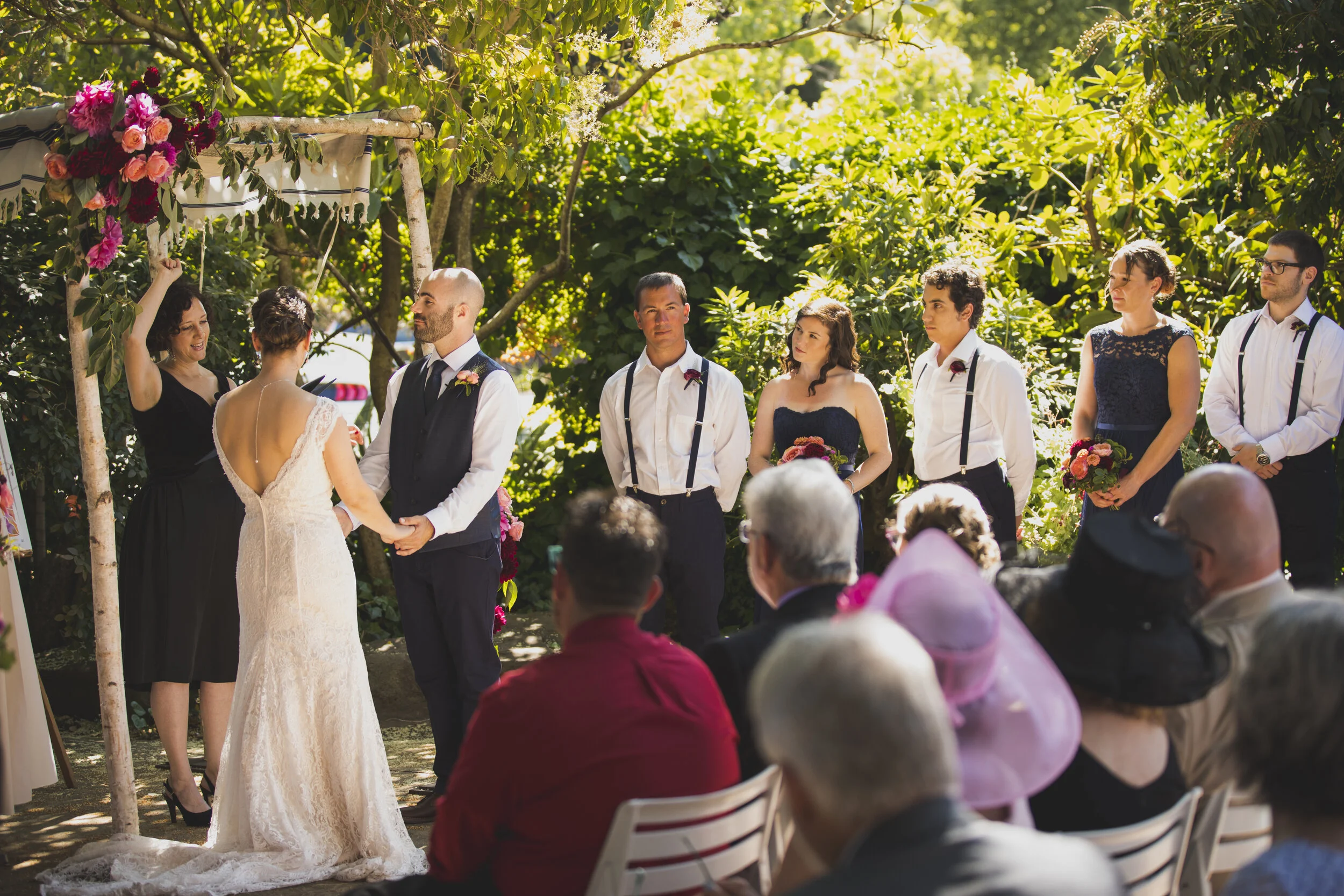Modern Jewish Weddings in California
Modern Jewish Weddings in California
I get a lot of requests to perform modern Jewish Weddings in California: Jew-ish (emphasis on the ish) wedding ceremonies, interfaith wedding ceremonies (Jewish-Catholic, Jewish-Hindu, Jewish-Buddhist), relatable and reimagined Jewish wedding ceremonies, earth-based Jewish ceremonies (honoring our new-moon-blessing, rams-horn-blowing, lulav-shaking, pagan roots), and Jewish weddings for LGBTQIA+ couples (which many rabbis simply refuse to perform).
Coming, as I do, from an orthodox Jewish family in New York, from a lineage of kohanim (Jewish high priests) on both my mother and father's sides, and from a family of cantors, including my Zaddy, Shlomo, and my brother, Aryeh, I have an innate understanding of Jewish rituals and traditions. And, because I left that staunchly religious way of life when I was in my early twenties to study world wisdom traditions and indigenous and earth-based spirituality, I also have a universalist and cross-cultural understanding of and appreciation for ceremonies, rituals and prayers that transcend religion.
One of my favorite things to do is to combine these different expressions of lineage, heritage, religion and modern sensibilities, i.e. relevance, in interfaith, mixed-faith, inter-spiritual, Jew-ish in modern Jewish weddings in California.
We might sign a ketubah (a traditional marriage contract), but the text might be a modern rendering of this ancient custom, written in English or Hebrew (versus Aramaic), and with humanistic wedding vows, versus the more religious Jewish ones. {A fun little aside: traditional religious, Jewish ketubahs clearly stipulate that a man is legally obliged to sexually satisfy his wife. i.e. sexual pleasure is a woman’s right, and it is her husband’s obligation to provide it!}
We might stand under a chuppah (Jewish wedding canopy), which is perhaps the most universally recognized symbol of a Jewish wedding ceremony. It is said that a chuppah is a holy awning, a spiritually charged arena, a consecrated space, and a protective structure under which the divine presence can be felt. It was once legally necessary to marry under a chuppah in order for a Jewish marriage to be solemnized. The chuppah in the photo above, which was taken by Blake Weber at Rancho Soquel, was made by the couple’s friends, and the poles of the chuppah were held by the couple’s bridal party during the ceremony.
Photo credit: WeddingsByGuru
And the chuppah in the photograph below was made with materials that were gathered from around the world and woven together with songs and prayers by a close friend of the couples.
We might read or sing one or more of the Sheva Brachot (the seven blessings). If only reciting one, I usually recommend that couples go with the seventh and final blessing, in which ten synonyms for happiness are named. In this blessing we reach the crescendo of joy, and the height of merriment! It's a jubilation, an exaltation, and a real raise the roof moment! In a wedding ceremony I performed recently, I had my brother (the cantor) record the seventh blessing in traditional, Ashkenazi operatic style, and it was quite amazing to hear this ancient prayer reverberate through the California redwoods!
We might break a glass at the end of the ceremony to signify the completion of the ceremony, and the beginning of the celebration, at which time everybody exclaims a loud mazal tov (Hebrew for congratulations!) There are many interpretations about why Jews enact this ritual breaking of the glass, but it's hard to pin down a definitive explanation. I always provide some possible explanations, but I also strongly encourage couples to find their own relevance and meaning behind this ritual. In a recent interfaith wedding ceremony I performed at Bargetto Winery, the Jewish bride and her non-Jewish groom each broke a glass.
In another ceremony, the non-practicing Jewish groom wanted to lightheartedly incorporate something from his heritage, so we wove his sarcastic Jewish sense of humor, with his karate practice into the breaking of the glass ritual…
“As a final gesture, the groom has asked that we include a token nod to his faith in this otherwise goyisha ceremony. So let’s indulge him! It's a Jewish custom to end a wedding ceremony with the groom stomping on a glass. There are many explanations for why this ritual is enacted, and one of the lesser-known ones is that boys quite simply like to break things! The shattering of the glass ends the ‘sacred pause’ of ceremonial time, and is universally followed by a loud, communal Mazel Tov (congratulations in English.) So, after the groom attempts to fumikomi (i.e. karate chop) this poor glass, please join me in uttering a resounding MAZEL TOV!”
In the case of more modern, non-traditional, interfaith or mixed-faith wedding ceremonies, we might have some Jewish elements, and some elements from other faith traditions or spiritual lineages. In the case of the African-Jewish wedding ceremony at Sequoia Retreat Center photographed by Vanessa Lain, the couple both broke a glass and jumped the broom to honor their traditions, mark the end of the ceremony, and symbolize the crossing of the threshold of marriage.
There are endless way to honor your Jewish roots r(whether religious or cultural) in ways that are authentic and true to you, and to blend your faiths in ways that feel respectful and enlivening for everyone involved.


